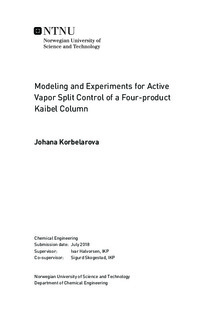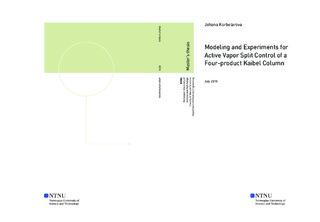| dc.description.abstract | Kaibel column is studied as an energy efficient way of distillation. Kaibel column and other thermally coupled arrangements are introduced in theoretical part with focus on different approaches to control of these columns. The active vapor split as a controlled variable is reviewed.
The pressure drop evolution in Kaibel column is studied to understand its dependency on column variables. The known approaches for estimation of pressure drop are summarized in theoretical part.
The pressure drop in Kaibel column is studied experimentally. The pressure drop is strongly dependent on energy input. The total pressure drop increases, if one of the branches is closed, and the magnitude depends on amount of packing. The composition is also important factor for pressure drop, the feed with higher molecular weight, the pressure drop is higher. The change of liquid split does not have particular influence on pressure drop.
The model for pressure drop estimation in Kaibel column is created. The model is able to compute steady state values for total pressure drop, pressure drop in prefractionator, and main column, and vapor flows into respective branches. The input variables are reboiler duty, vapor split and temperature and composition in reboiler. The simulations show similar dependency on reboiler duty and vapor split as seen during experiments.
Experimental verification of different control structures for Kaibel column is reported. Product valves of distillate, and both side streams were used as manipulated variables together with liquid split, resp. vapor split.
The four-point temperature control of Kaibel column is studied. Control structure with liquid split control can reject feed disturbances, and setpoint changes of all variables.
For active vapor split control, the sensitivity of controlled temperature is strongly dependent on the position of the step change in manipulated variable. The system was able to reject setpoint change, liquid split disturbance and setpoint change of side stream control loop temperature.
The five-point temperature control of Kaibel column was introduced. The addition of second control loop to the prefractionator enables both liquid and vapor split control. The open loop experiments show incoherent responses for temperatures in top part of prefractionator. The strong dependency on control loop S1 was found. The sensitivity towards the liquid split is also rather low. | |

